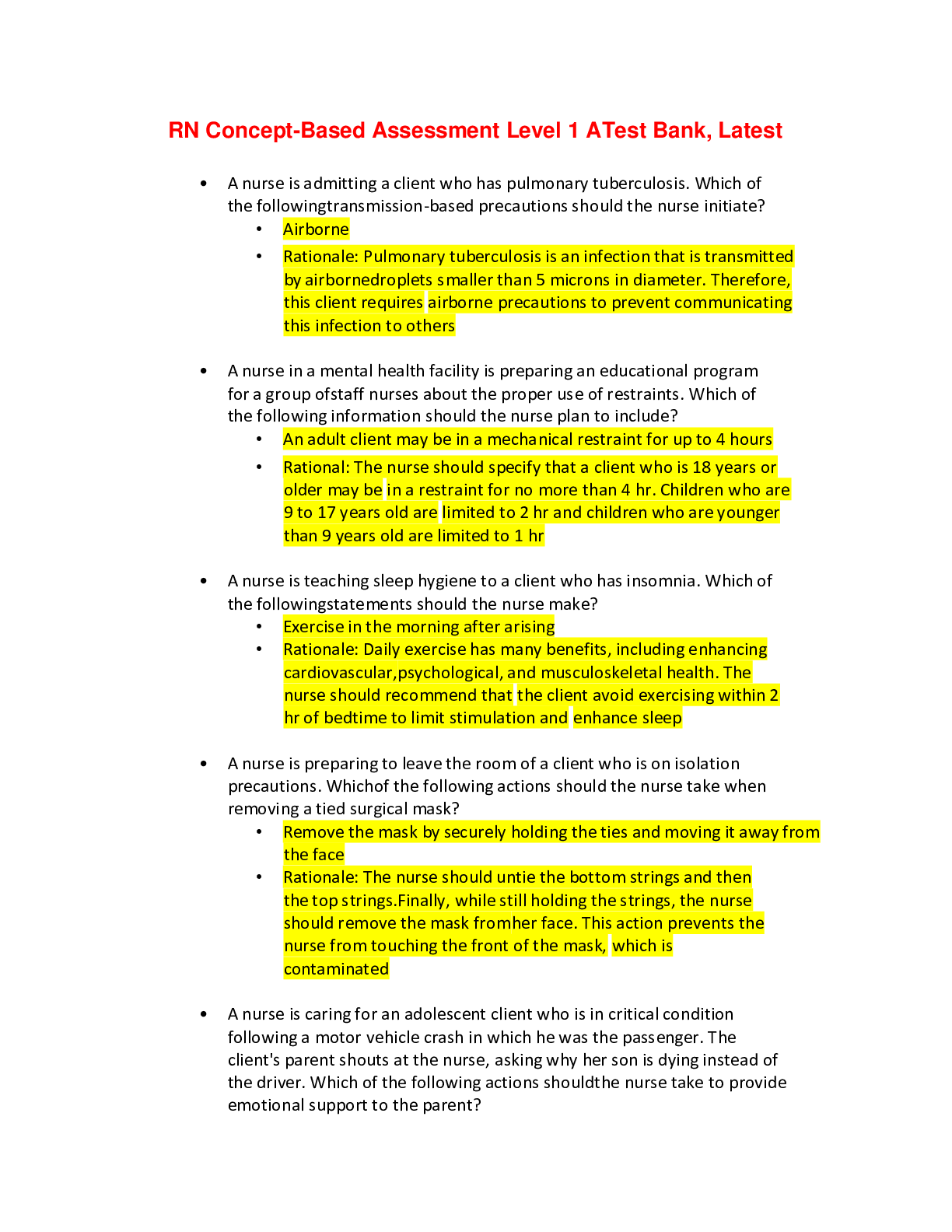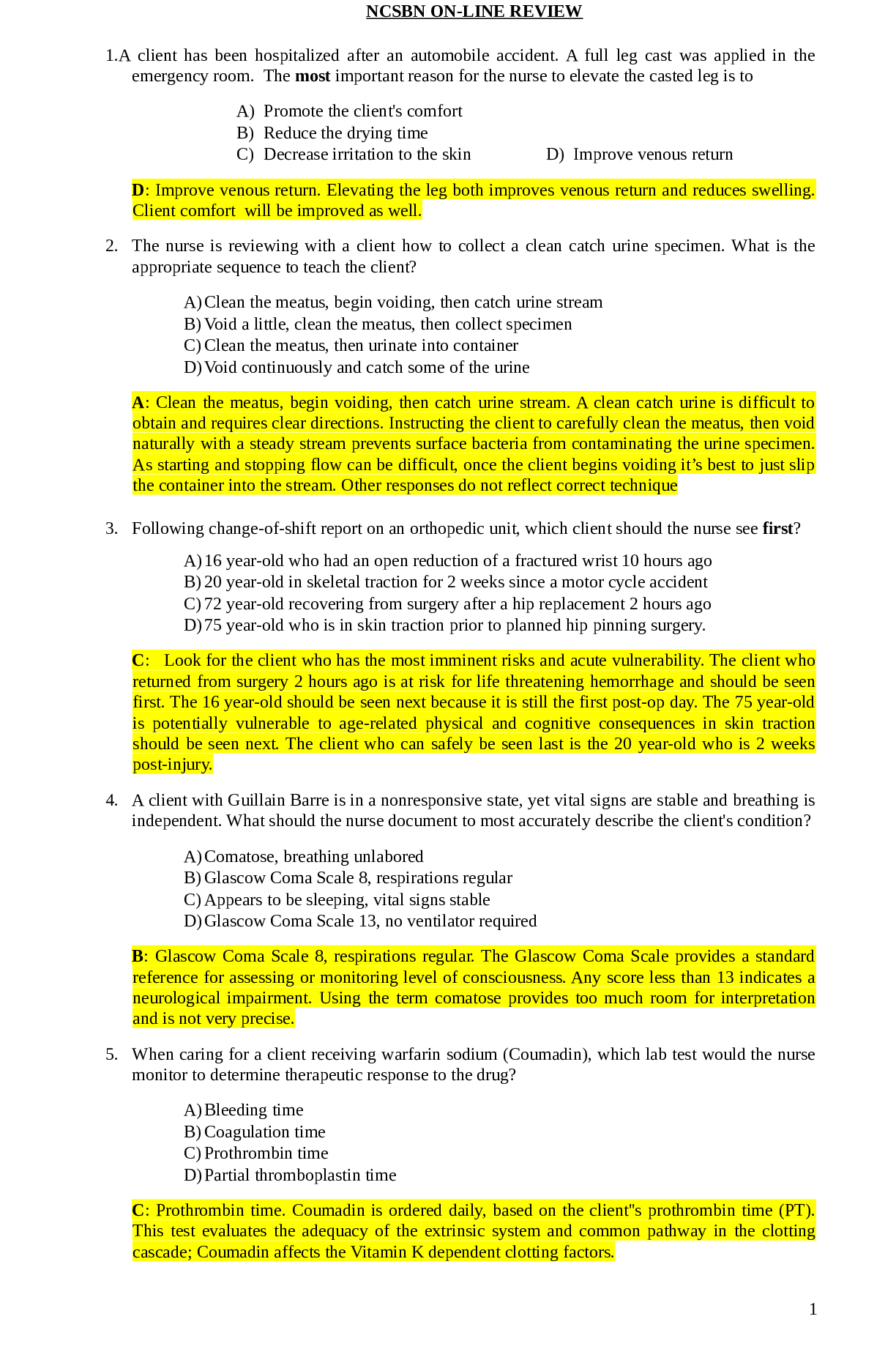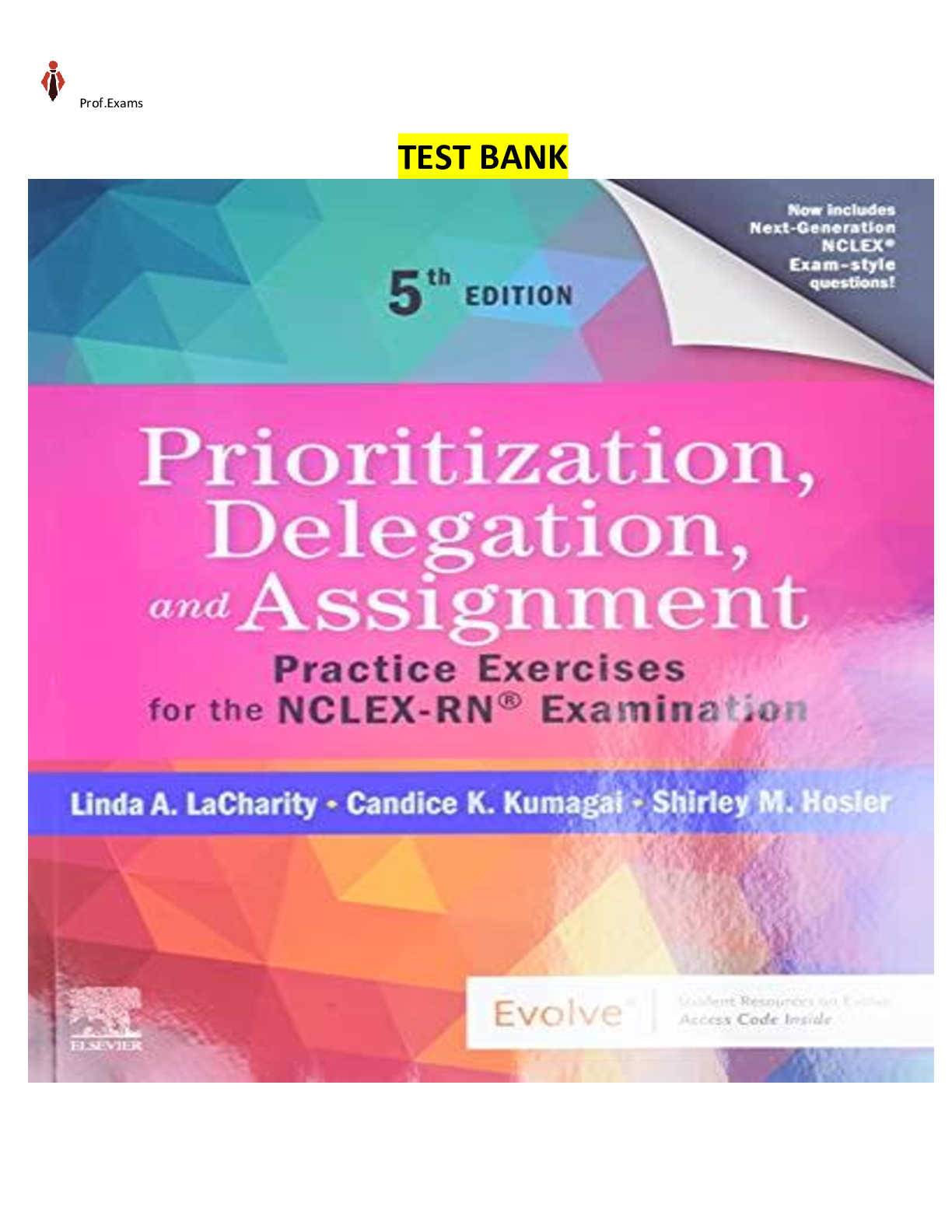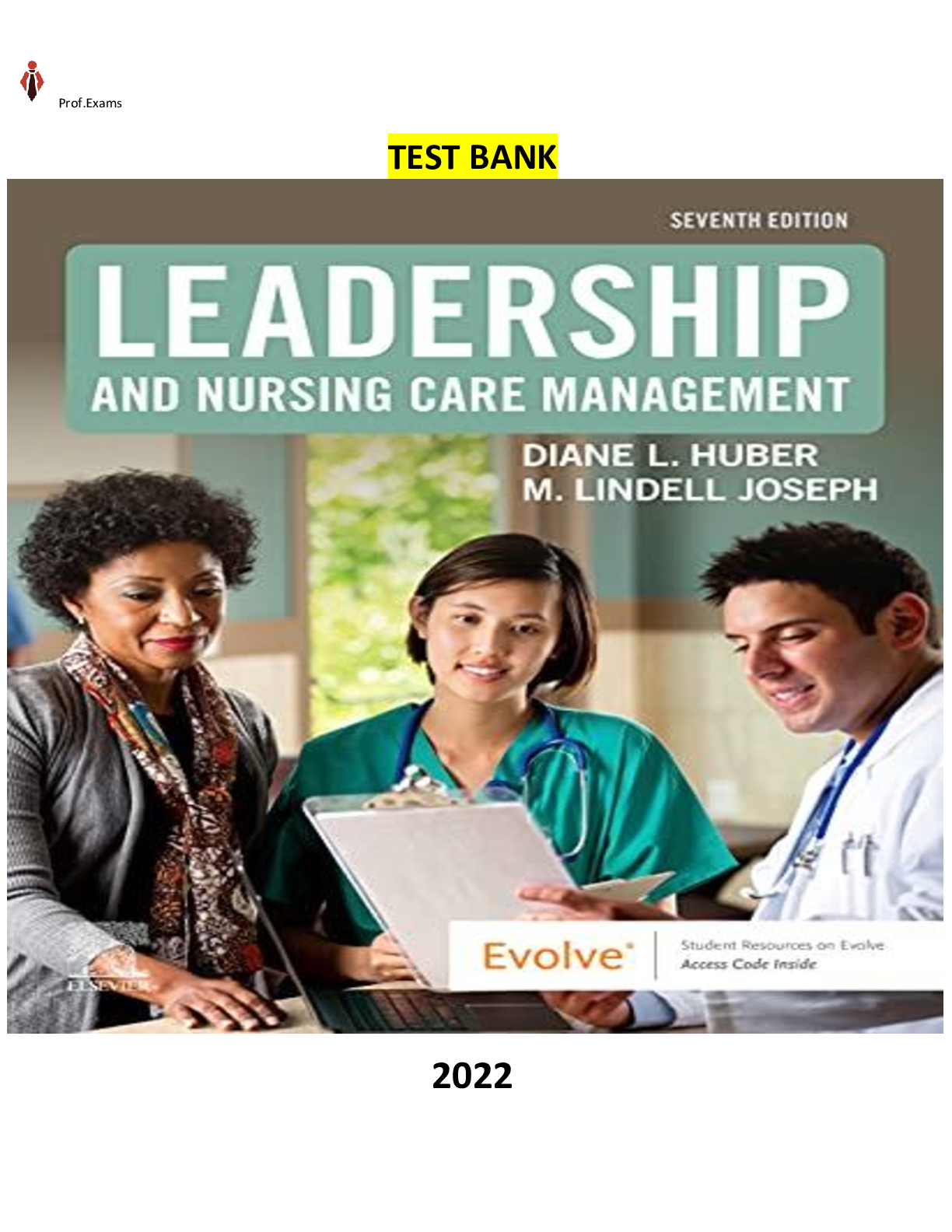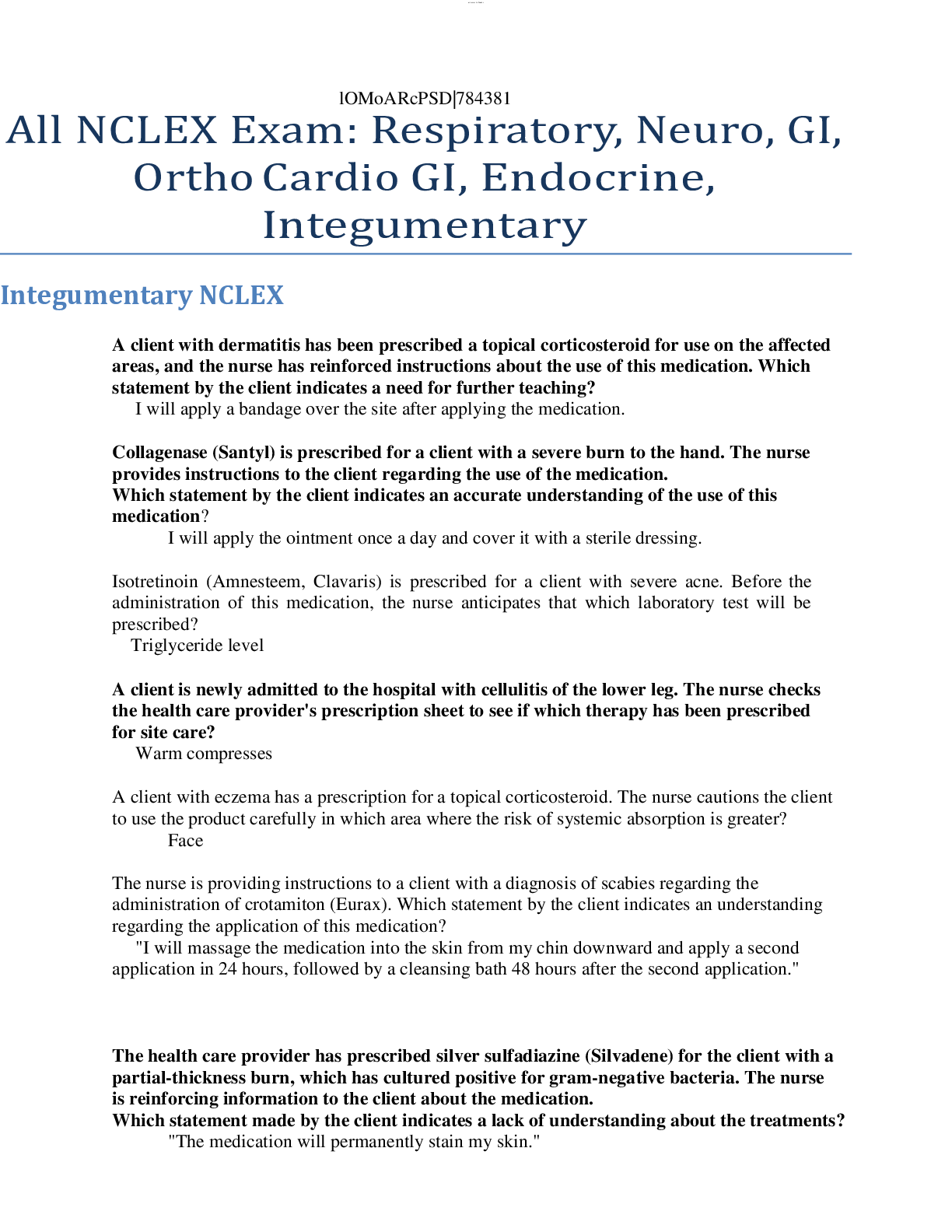*NURSING > TEST BANK > Chapter 15: NURS 340 Preparation For The Nclex Questions and Answers ,100% CORRECT (All)
Chapter 15: NURS 340 Preparation For The Nclex Questions and Answers ,100% CORRECT
Document Content and Description Below
Chapter 15: NURS 340 Preparation For The Nclex Questions and Answers Origin: Chapter 15, 1 1.A nurse is conducting a health history for a 1-month-old with an infectious disorder. Which segment of t... he health history would be most helpful for the nurse when determining if the infant developed the infection from the mother? A) Family history B) Past medical history C) Home treatments D) Present illness history Ans: B Feedback: Past medical history will provide information about the mother's pregnancy and delivery, giving insight into the possibility of maternal transmission of the infection. Family history would provide information about lack of immunizations or recent infectious or communicable diseases. Home treatments and present illness history would provide no information about the possibility of maternal transmission of infection. Origin: Chapter 15, 2 2. While reviewing various studies about the use of antipyretics possibly prolonging illness, the nurse notes that there are benefits to their use for the child with fever. What would the nurse identify as the best explanation related to the benefit of antipyretics? A) They slow the growth of bacteria. B) They increase neutrophil production. C) They encourage T-cell proliferation. D) They help decrease fluid requirements. Ans: D Feedback: Antipyretics provide symptomatic relief by increasing comfort in the child and decreasing fluid requirements, which helps to prevent dehydration. Fever has been shown to slow the growth of bacteria, increase neutrophil production, and encourage T-cell proliferation. Origin: Chapter 15, 3 3. The nurse is caring for a neonate who is suspected of having sepsis. Which assessment findings would the nurse interpret as most indicative of sepsis? A) Rash on face B) Edematous neck C) Hypothermia D) Coughing Ans: C Feedback: Hypothermia is a sign of sepsis in neonates. A rash on the face is a symptom of scarlet fever. An edematous neck is a sign of diphtheria. Paroxysmal coughing is a symptom of pertussis. Origin: Chapter 15, 4 4. The nurse is preparing a plan of care for a 5-year-old boy with chickenpox. Which nursing intervention should be questioned? A) Administer antipyretics as ordered. B) Keep the child's fingernails short. C) Monitor fluid intake and output. D) Provide alcohol baths as needed. Ans: D Feedback: Treatments such as sponging the child with alcohol or cold water are not appropriate interventions for fever management. Rather, the nurse would use tepid sponge baths and cool compresses. Administering antipyretics, keeping the child's fingernails short, and monitoring intake and output are appropriate. Origin: Chapter 15, 5 5. The nurse is developing a teaching plan for the mother of a 4-year-old girl with cold and fever. What would the nurse include in this teaching plan? A) Keeping the child covered and warm B) Calling the doctor if the child's fever lasts more than 36 hours C) Ensuring fluid intake to prevent dehydration D) Observing for changes in alertness resulting from brain damage Ans: C Feedback: Teaching the mother to ensure fluid intake is important because fever can cause dehydration. The child should be dressed lightly. There is no need to call the doctor unless the child's fever lasts more than 3 to 5 days or the fever is greater than 105°F. A rapid rise to a high fever can cause a febrile convulsion, but it does not lead to brain damage. Origin: Chapter 15, 6 6. After teaching a mother how to remove a tick from her 6-year-old boy's arm, the nurse determines that additional teaching is needed when the mother makes what statement? A) "I'll protect my fingers with a paper towel." B) "I'll grasp the tick and pull it away quickly." C) "I should put the tick in a plastic bag in the freezer." D) "I need to grasp the tick close to the child's skin." Ans: B Feedback: Grasping the tick and pulling it away quickly would indicate the need for additional teaching. When removing a tick, the mother should use fine-tipped tweezers while protecting her fingers with a tissue, paper towel, or latex gloves. The mother should grasp the tick as close to the skin as possible and pull upward with steady, even pressure. Once removed, the mother should place the tick in a sealable plastic bag in the freezer in case the child becomes sick and identification of the tick is needed. Origin: Chapter 15, 7 7. The nurse is performing a physical examination of an 8-year-old girl who was bitten by her kitten. Which assessment would lead the nurse to suspect cat-scratch disease? A) Swollen lymph nodes B) Strawberry tongue C) Infected tonsils D) Swollen neck Ans: A Feedback: Lymph nodes, especially under the arms, can become painful and swollen due to cat- scratch disease. Strawberry tongue is typical of scarlet fever. Infected tonsils and an edematous neck are symptoms of diphtheria. Origin: Chapter 15, 8 8.A group of nursing students are reviewing the six links in the chain of infection and the nursing implications for each. The students demonstrate understanding of the information when they identify which precaution as helping to break the chain of infection to the susceptible host? A) Keeping linens dry and clean B) Maintaining skin integrity C) Washing hands frequently D) Coughing into a handkerchief Ans: B Feedback: Maintaining the integrity of the child's skin and mucous membranes is a precaution that will break the chain of infection at the susceptible host. Keeping linens dry and clean is a precaution to take at the reservoir link. Washing hands frequently breaks the chain at the mode of transmission. Coughing into a handkerchief is a precaution for the portal of exit. Origin: Chapter 15, 9 9. The nurse is performing a physical examination on a 9-year-old boy who has experienced a tick bite on his lower leg and is suspected of having Lyme disease. Which assessment finding would the nurse expect to find? A) Swelling in the neck B) Confusion and anxiety C) Ring-like rash on lower leg D) Hypersalivation Ans: C Feedback: A ring-like rash at the site of the tick bite is characteristic for Lyme disease. Swelling in the neck is a symptom of mumps. Confusion, anxiety, and hypersalivation are symptoms of rabies. Origin: Chapter 15, 10 10. The nurse determines that it is necessary to implement airborne precautions for children with which infection? A) Measles B) Streptococcus group A C) Rubella D) Scarlet fever Ans: A Feedback: Airborne precautions are designed to reduce the risk of infectious agents transmitted by airborne droplet nuclei or dust particles such as for children with measles, varicella, or tuberculosis. Droplet precautions would be used for children with streptococcal group A infections, rubella, and scarlet fever. Origin: Chapter 15, 11 11.A child is diagnosed with scarlet fever. The nurse is reviewing the child's medical record, expecting which medication to be prescribed for this child? A) Ibuprofen B) Acyclovir C) Penicillin V D) Doxycycline Ans: C Feedback: Penicillin V is the antibiotic of choice for the treatment of scarlet fever. Ibuprofen is used to treat fever. Acyclovir is used to treat viral infections. Doxycycline, a tetracycline, is the drug of choice for treating Rocky Mountain spotted fever. Origin: Chapter 15, 12 12.A mother brings her 8-year-old son for evaluation because of a rash on his lower leg. Which finding would support the suspicion that the child has Lyme disease? A) Playing in the woods about a week ago B) Rash is papular and vesicular C) High fever occurring about 4 days before the rash D) Complaints of extreme pruritus with visible nits Ans: A Feedback: Lyme disease is caused by the bite of an infected tick, with a rash appearing 7 to 14 days after the tick bite. Ticks are commonly found in wooded areas. Therefore, reports of the child playing in the woods about 7 days ago would support the diagnosis of Lyme disease. A papular and vesicular rash is commonly associated with varicella (chickenpox). A high fever for 3 to 5 days before a rash suggests roseola. Extreme pruritus with visible nits would suggest pediculosis. Origin: Chapter 15, 13 13. What would be most important to include in the teaching plan for parents of a child with pinworm? A) "Seal the child's clothing in a plastic bag for at least 10 days." B) "Be sure your child wears shoes at all times." C) "Make sure the child washes his hands after using the bathroom." D) "After applying this special cream, leave it on for about 8 to 10 hours." Ans: C Feedback: The most effective measure to prevent pinworms or a recurrence is good hand hygiene, especially after using the bathroom and before eating. Sealing the child's clothing in a plastic bag is appropriate for pediculosis capitis. Having the child wear shoes at all times is helpful in preventing hookworm. Use of a cream that remains on for a specified time is associated with scabies. Origin: Chapter 15, 14 14. After teaching the parents of a child with varicella zoster, the nurse determines that the parents have understood the teaching when they state that their child can return to school at which time? A) After day 5 of the rash B) When the rash is completely healed C) Once the rash appears D) After the lesions have crusted Ans: D Feedback: Children with chickenpox (varicella zoster) can return to school once the lesions have crusted. Origin: Chapter 15, 15 15. After teaching a class on the role of white blood cells in infection, the instructor determines that the teaching was successful when the class identifies which type of white blood cells as important in combating bacterial infections? A) Neutrophils B) Eosinophils C) Basophils D) Lymphocytes Ans: A Feedback: Elevations in certain portions of the white blood cell count reflect different processes occurring in the body. Neutrophils function to combat bacterial infection. Eosinophils function in allergic disorders and parasitic infections. Basophils combat parasitic infections and some allergic disorders. Lymphocytes function in viral infections. Origin: Chapter 15, 16 16.A woman gives birth to a healthy newborn. As part of the newborn's care, the nurse instills erythromycin ophthalmic ointment as a preventive measure for which sexually transmitted infection (STI)? A) Genital herpes B) Hepatitis B C) Syphilis D) Gonorrhea Ans: D Feedback: To prevent gonococcal ophthalmia neonatorum, erythromycin or tetracycline ophthalmic ointment is instilled into the eyes of all newborns. This action is required by law in most states. The ointment is not used to prevent conditions related to genital herpes, hepatitis B, or syphilis. Origin: Chapter 15, 17 17.A nursing instructor is teaching a group of students about the action of antipyretic agents in children. The instructor determines that the teaching has been successful when the students identify which action as the primary action? A) Cause vasodilation to promote heat loss B) Decrease the temperature set point C) Block release of histamine D) Promote prostaglandin production Ans: B Feedback: Antipyretics act to decrease the temperature set point in children with elevated temperatures by inhibiting the production of prostaglandins, which leads to heat loss through vasodilation and sweating. Antihistamines block the release of histamine. Origin: Chapter 15, 18 18.A nurse is instructing a parent on how to obtain a stool culture for ova and parasites from a child with diarrhea. What would the nurse include in the teaching plan? A) "Give the child bismuth and then collect the next specimen." B) "Obtain the specimen from the toilet after the child has a bowel movement." C) "Keep the specimen from coming into contact with any urine." D) "Bring the specimen to the laboratory on the third day." Ans: C Feedback: A stool specimen for culture must be free of urine, water, and toilet paper. Therefore, the parent needs to understand how to collect the specimen so that it does not come into contact with any these. In addition, the specimen should not be retrieved out of toilet water. Mineral oil, barium, and bismuth interfere with the detection of parasites. In such cases, specimen collection should be delayed for 7 to 10 days. Once the specimen is collected, it should be brought to the laboratory immediately. Origin: Chapter 15, 19 19. The nurse is preparing to obtain a blood specimen via capillary heel puncture. Which action would be most appropriate for the nurse to do? A) Apply a cool compress for several minutes before collection. B) Elevate the extremity used after puncturing it. C) Squeeze the area to facilitate specimen collection. D) Wipe away the first drop of blood with dry gauze. Ans: D Feedback: When obtaining a blood specimen by capillary puncture, the nurse should wipe away the first drop of blood with a cotton ball or dry gauze pad and then collect the sample without squeezing the foot to prevent possible hemolysis. Prior to the puncture, the nurse can apply a commercial heel warmer or warm compress for several minutes to promote vasodilation. The extremity being used should be placed in the dependent position after puncturing the heel. Origin: Chapter 15, 20 20. The nurse is assessing the tympanic temperature of several children. The nurse documents that the child with which temperature reading has a fever? A) 98.2° F (36.8° C) B) 99.2° F (37.3° C) C) 100° F (37.8° C) D) 100.8° F (38.2° C) Ans: D Feedback: A tympanic temperature greater than 100.4° F (greater than 38° C) is defined as fever. An oral temperature of 100° F (greater than 37.8° C) would identify a fever. An axillary temperature of 99° F (greater than 37.2° C) would identify a fever. Origin: Chapter 15, 21 21.A school-aged child with an infectious disease is placed on transmission-based precautions. Which nursing diagnosis would be the priority? A) Impaired skin integrity related to trauma secondary to pruritus and scratching B) Fluid volume deficit related to increased metabolic demands and insensible losses C) Social isolation related to infectivity and inability to go to the playroom D) Deficient knowledge related to how infection is transmitted Ans: C Feedback: Children who are placed on transmission-based precautions are not allowed to leave their rooms and are not allowed to go to common areas such as the playroom or schoolroom. Thus, they are at risk for social isolation. Impaired skin integrity, fluid volume deficit, and deficient knowledge may be appropriate but would depend on the infectious disease diagnosed. Origin: Chapter 15, 22 22.A group of nursing students are reviewing information about childhood infectious diseases. The students demonstrate understanding of this information when they identify which disease as a common childhood exanthema? A) Mumps B) Rabies C) Rubella D) West Nile virus Ans: C Feedback: Rubella is a common childhood exanthema. Mumps is a viral infection. Rabies is a zoonotic infection. West Nile virus is a vector-borne disease. Origin: Chapter 15, 23 23. The parents of a 5-year-old have just found out that their child has head lice. Which statement by the parents would support the nursing diagnosis of deficient knowledge? A) "I can't believe it. We're not unclean, poor people." B) "We'll have to get that special shampoo." C) "Everybody in the house will need to be checked." D) "That explains his complaints of itching on his neck." Ans: A Feedback: Head lice is not an indication of poor hygiene or poverty. It occurs in all socioeconomic groups. Thus, the parents' statement about being unclean and poor reflects a lack of knowledge about the infection. A pediculicide is used to wash the hair to treat the infestation. Household contacts need to be examined and treated if affected. Extreme pruritus is the most common symptom, with nits or lice especially behind the ears or at the nape of the neck. Origin: Chapter 15, 24 24. While obtaining a health history from a male adolescent during a well check-up, the nurse assesses his sexual behavior and risk for sexually transmitted infections. Based on the information, the nurse plans to teach the adolescent about using a condom. What would the nurse include in the teaching plan? A) "You can reuse a condom if it's within 3 hours." B) "Store your condoms in your wallet so they are ready for use." C) "Put the condom on before engaging in any genital contact." D) "Use petroleum jelly with a latex condom for extra lubrication." Ans: C Feedback: When teaching an adolescent about condom use, the nurse should tell the adolescent to put the condom on before any genital contact. A new condom should be used with each act of sexual intercourse; a condom should never be reused. Condoms should be stored in a cool, dry place away from direct sunlight and never stored in wallets, automobiles, or anywhere they could be exposed to extreme temperatures. Only water-soluble lubricants should be used with latex condoms. Oil-based or petroleum-based lubricants such as Vaseline can weaken latex condoms. Origin: Chapter 15, 25 25. An adolescent is diagnosed with gonorrhea. When developing the plan of care for this adolescent, the nurse would expect that she would also receive treatment for what? A) Chlamydia B) Syphilis C) Genital herpes D) Trichomoniasis Ans: A Feedback: Patients with gonorrhea usually receive treatment for chlamydia as well because patients often are coinfected. Coinfection with syphilis, genital herpes, or trichomoniasis is uncommon. Origin: Chapter 15, 26 26.A nurse suspects that an adolescent may have community-acquired methicillin-resistant Staphylococcus aureus (CAMRSA). What would the nurse expect to assess? Select all that apply. A) Participation in contact sport B) Recent cut on the lower leg C) History of a recent sore throat D) Raised fluctuant lesions E) Erythematous rash over the trunk and face Ans: A, B, D Feedback: With CAMRSA, skin and tissue infections are common, often appearing as a bump or skin area that is red, swollen, painful, and warm to the touch. There also may be fluctuance and purulent drainage. Participation in contact sports, openings in the skin such as abrasions and cuts, contact with contaminated items and surfaces, poor hygiene, and crowded living conditions are risk factors for CAMRSA. Recent sore throat and an erythematous rash on the trunk, face, and possibly the extremities are associated with scarlet fever. Origin: Chapter 15, 27 27.A child is diagnosed with a helminthic infection. Which treatments would the nurse expect to be prescribed? Select all that apply. A) Erythromycin B) Albendazole C) Pyrantel pamoate D) Acyclovir E) Metronidazole F) Permethrin Ans: B, C Feedback: Drugs used to treat helminthic infections include albendazole and pyrantel pamoate. Erythromycin is used to treat bacterial infections. Acyclovir is used to treat viral infections. Metronidazole is used to treat trichomoniasis. Permethrin is used to treat pediculosis. Origin: Chapter 15, 28 28. The client has a heavily draining wound for which there is an order to change the dressing every 4 hours. The nurse becomes busy and does not change the dressing as ordered. Which link in the chain of infection has the nurse allowed to flourish? A) Susceptible host B) Portal of exit C) Reservoir D) Mode of transmission Ans: C Feedback: The reservoir is the area where a pathogen grows and reproduces. Leaving the dressing unchanged allows for a dark, warm, nutrient rich, and moist environment where many organisms will thrive. A susceptible host is a person who cannot fight off an infection. The portal of exit is the way a pathogen exits the host. The mode of transmission is the way the pathogen travels. Origin: Chapter 15, 29 29. The parents of a 7-month-old child with an infection ask the nurse about how to treat their child's fever. After providing teaching, the parents voice understanding with which statements? Select all that apply. A) "Unless my child develops a fever over 102.2°F , I don't need to make an appointment with the physician." B) "Having a temperature over 38°C puts my child at risk for the infection spreading to the bloodstream." C) "I can use acetaminophen to help with the symptoms of the infection but it won't get rid of the infection." D) "Even though people get frightened, fevers are not a bad thing during an infection unless it gets too high." E) "Any fever is dangerous and can cause serious damage to brain cells if it goes on too long." Ans: A, C, D Feedback: In infants older than 3 months of age, fever less than 39°C (102.2°F) usually does not require treatment by a physician. Antipyretics, such as acetaminophen, provide symptomatic relief but do not change the course of the infection. A fever can actually enhance various components of the immune response. Infants younger than 3 months of age with a rectal temperature greater than 38°C should be seen by a physician or nurse practitioner because of increased risk of sepsis. Origin: Chapter 15, 30 30. The mother of a 4-year-old boy has contacted the physician's office. She reports her son was exposed to someone with chickenpox. She has inquired about when her son may show if he has gotten the disease. What information should be provided? A) The illness should be seen in a week if he has been exposed. B) Symptoms of the disease should show up within 24 to 48 hours of exposure. C) The incubation period for the disease is between 10 and 21 days. D) Younger children will have longer periods of incubation. Ans: C Feedback: Chickenpox is the common name for varicella. This condition has an incubation period of 10 to 21 days. [Show More]
Last updated: 1 year ago
Preview 1 out of 13 pages
Instant download
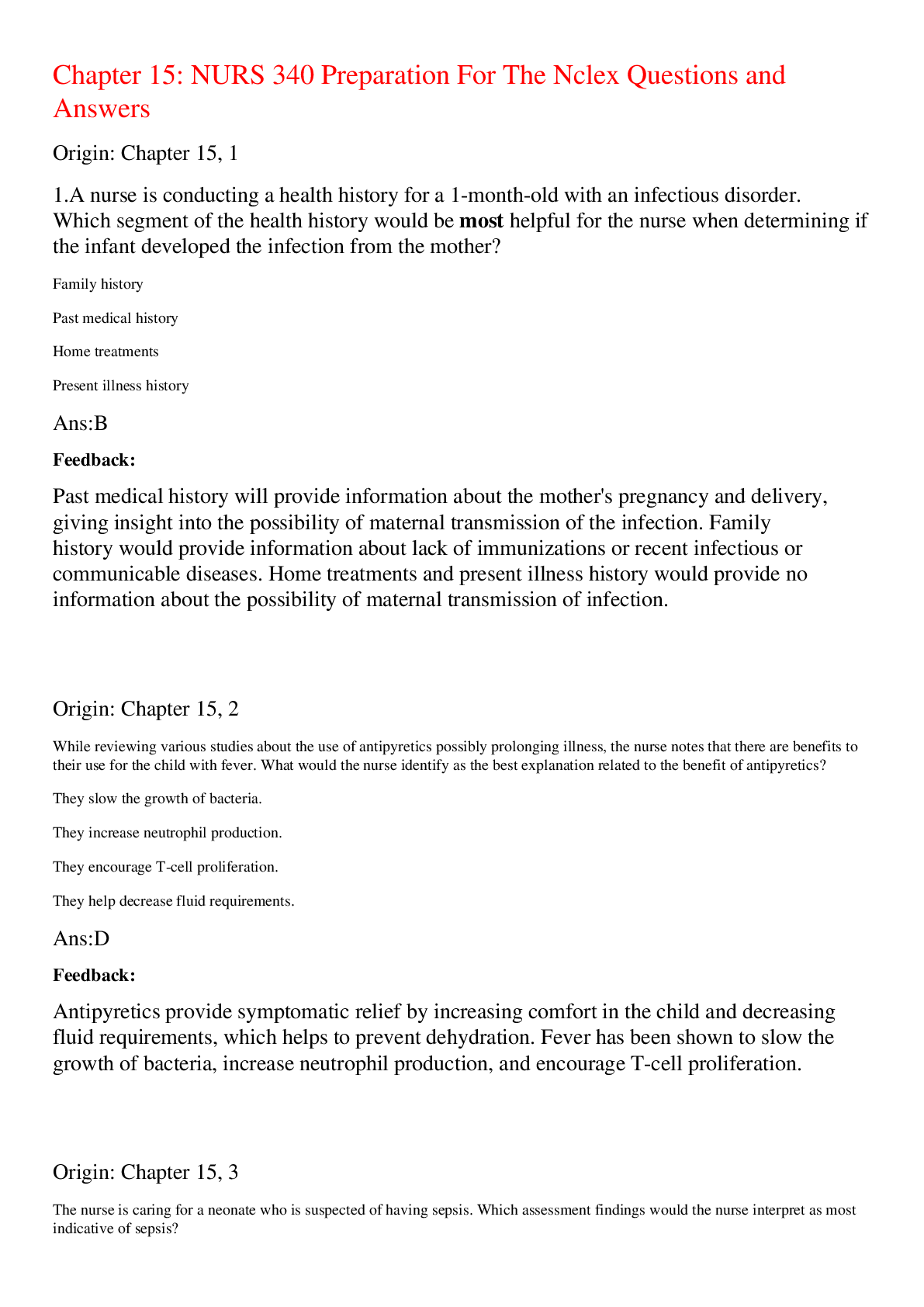
Instant download
Reviews( 0 )
Document information
Connected school, study & course
About the document
Uploaded On
Feb 13, 2023
Number of pages
13
Written in
Additional information
This document has been written for:
Uploaded
Feb 13, 2023
Downloads
0
Views
39










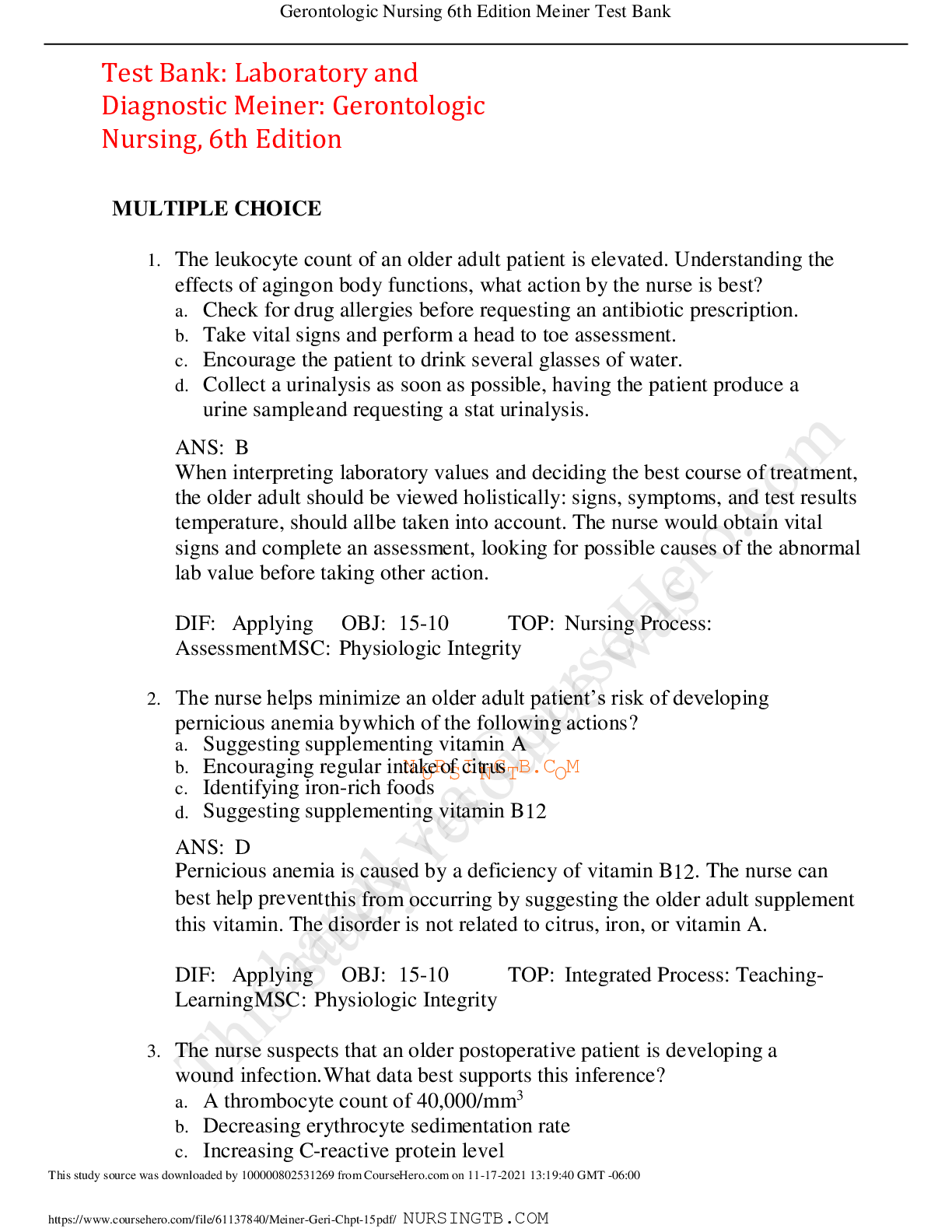


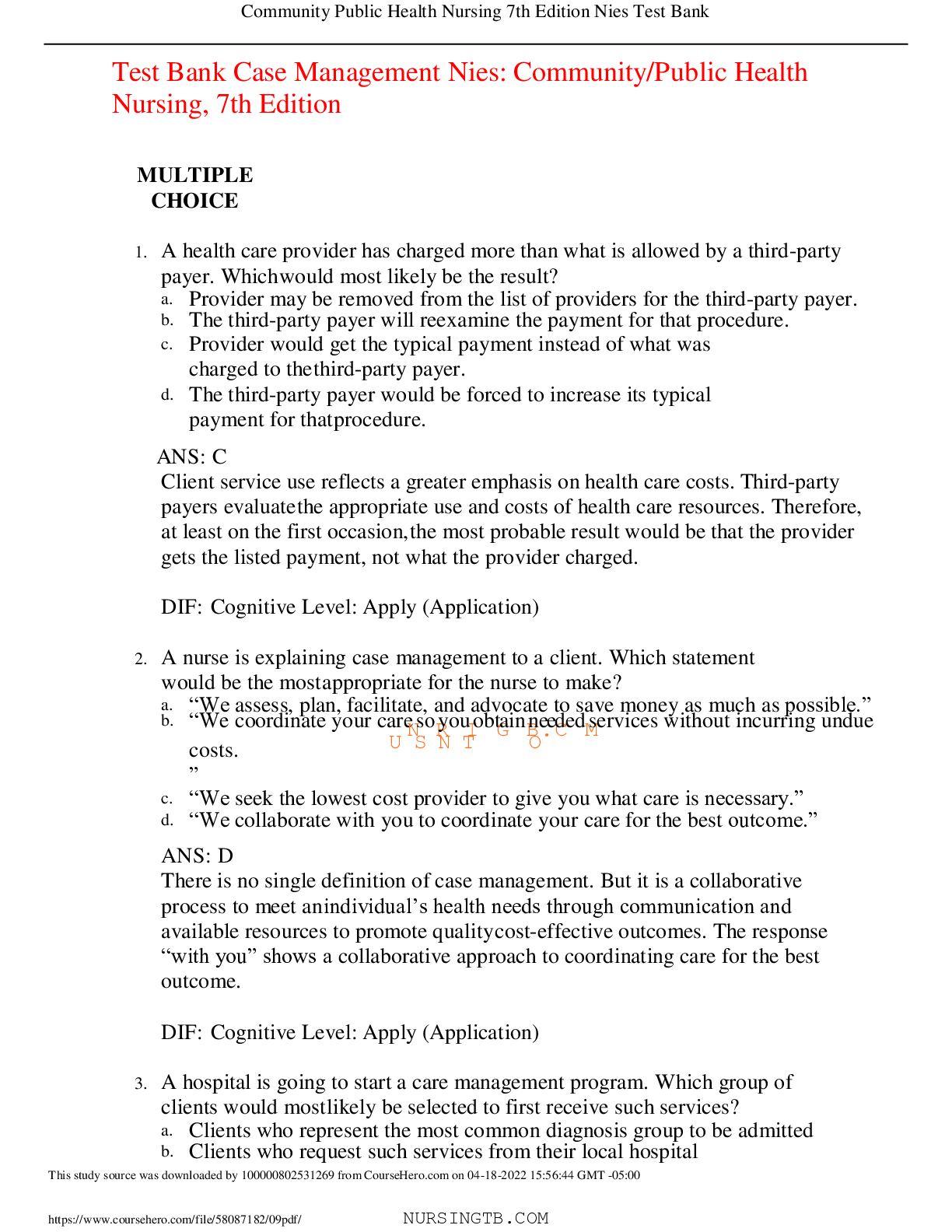


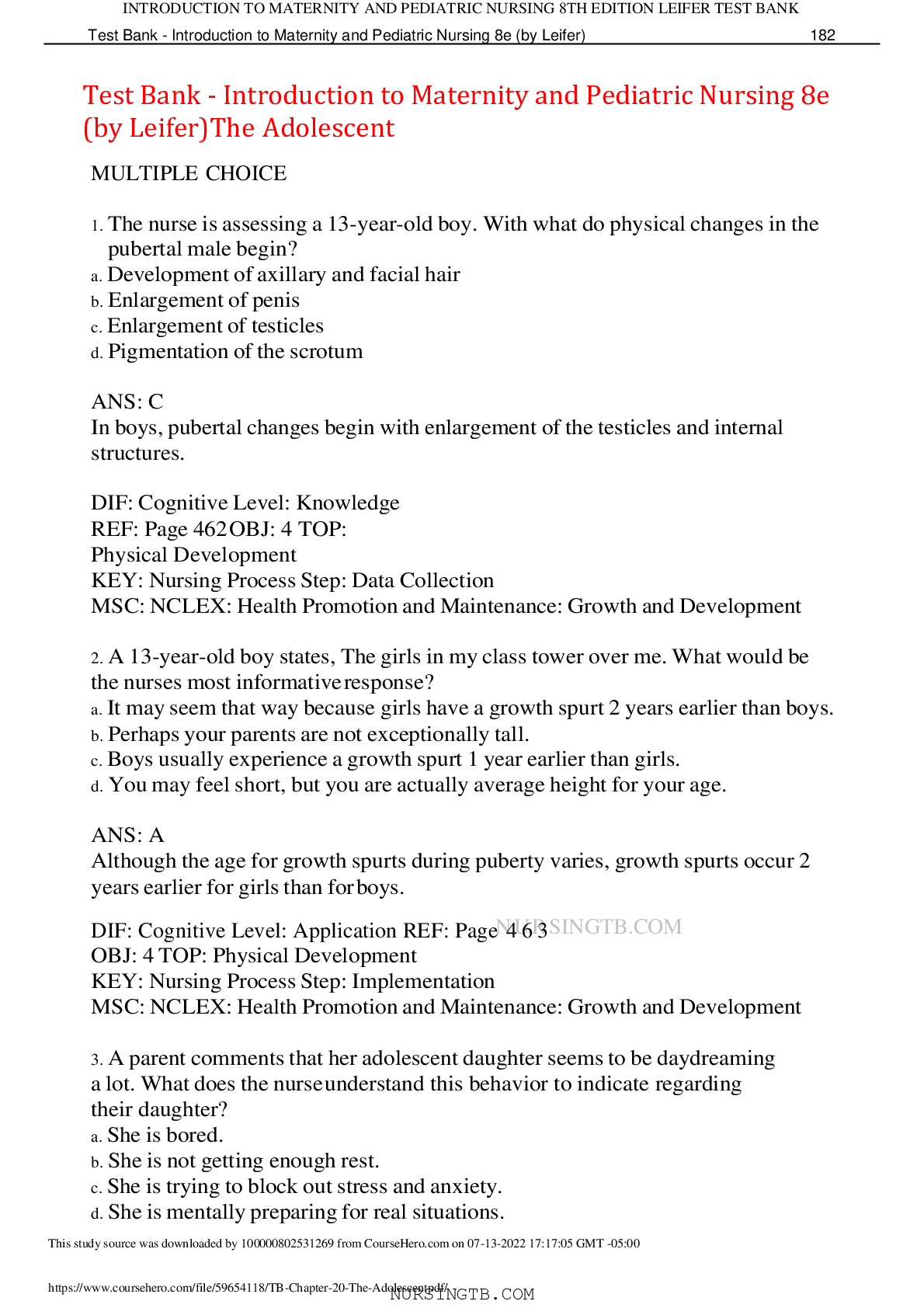
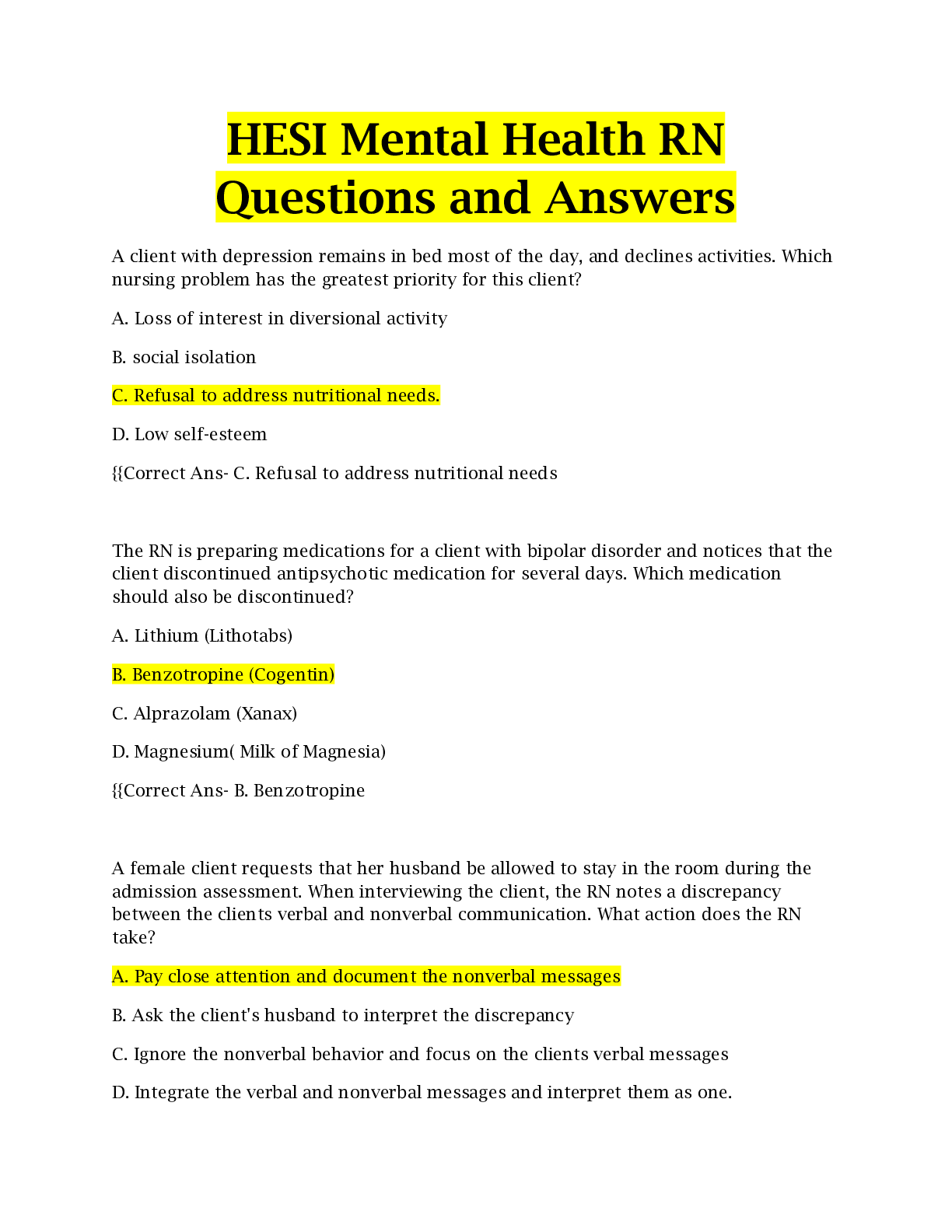



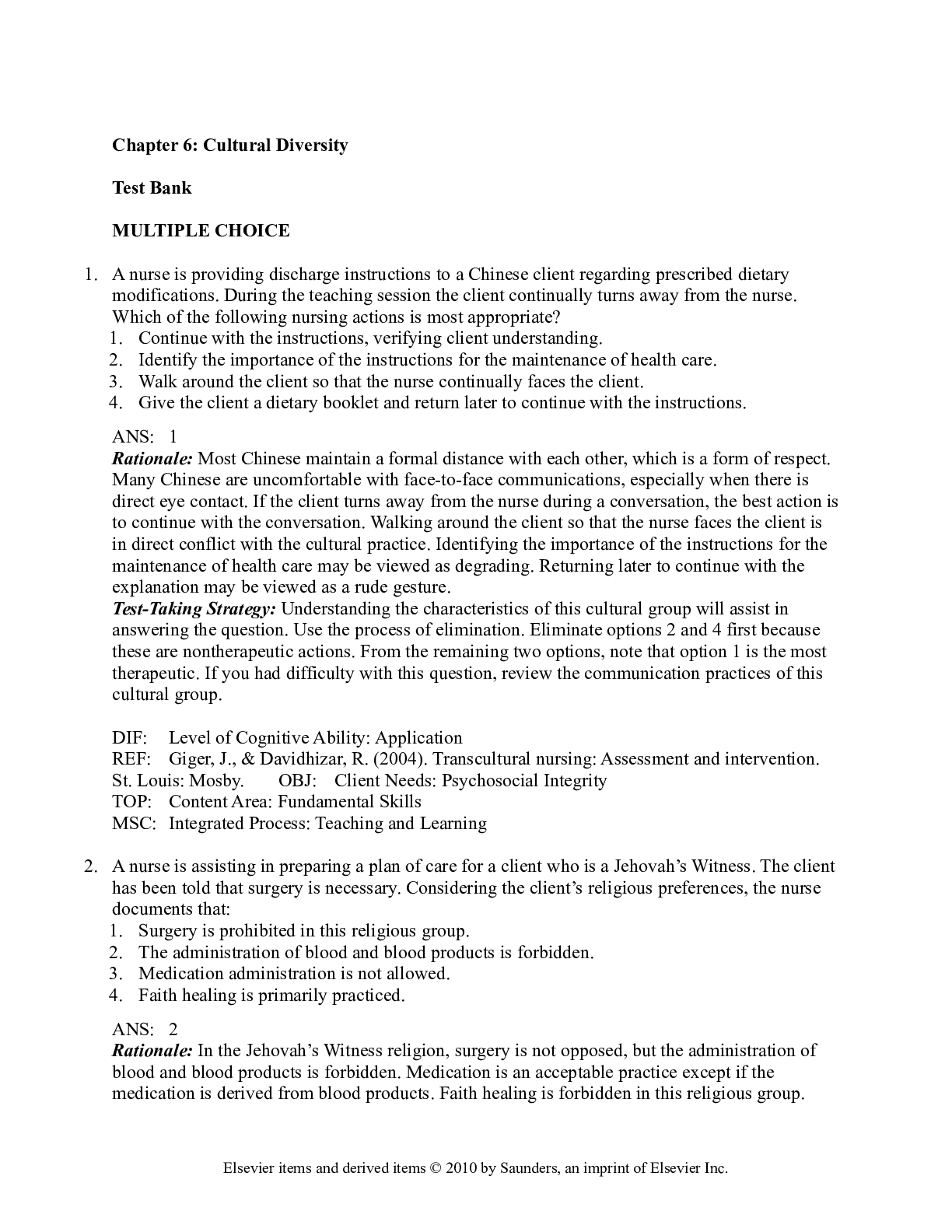
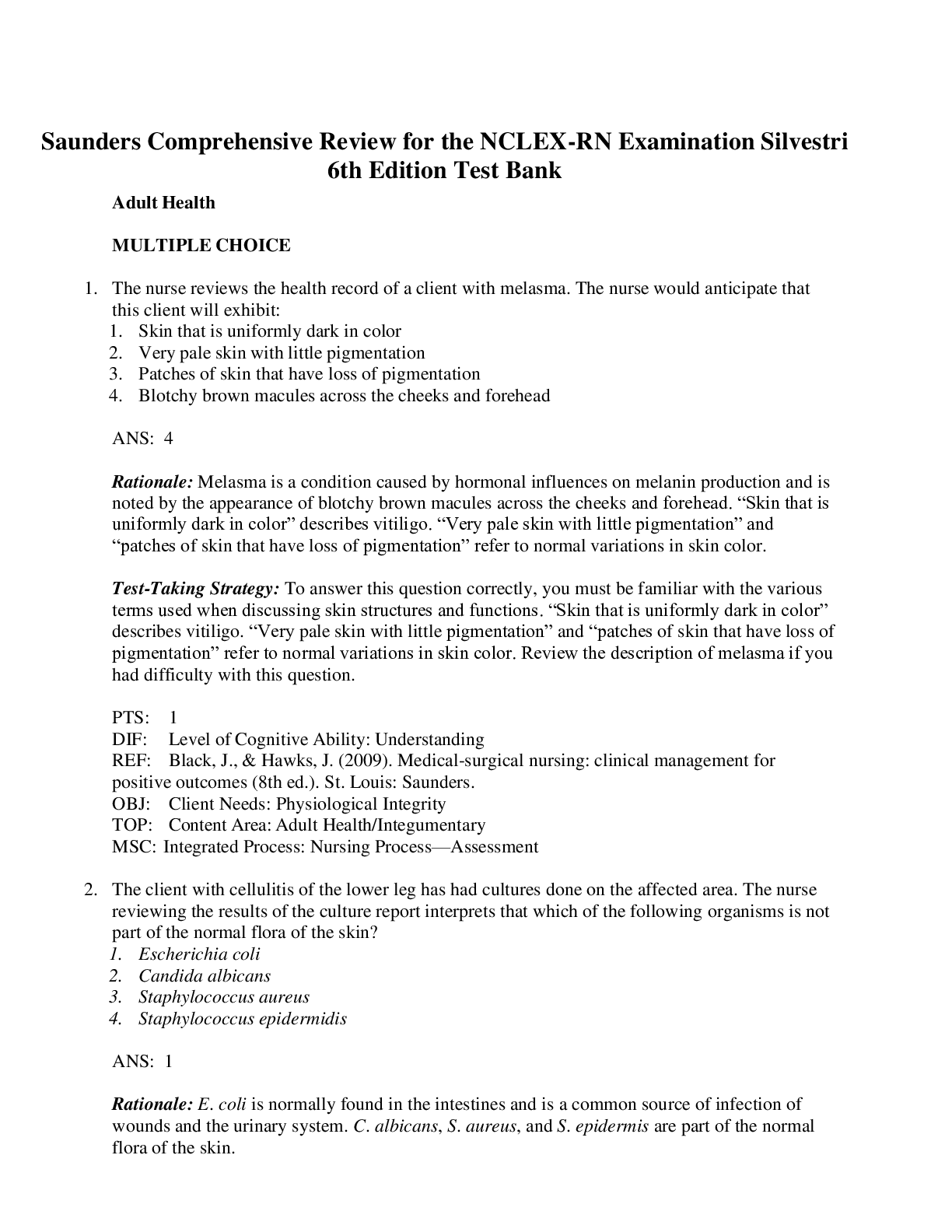
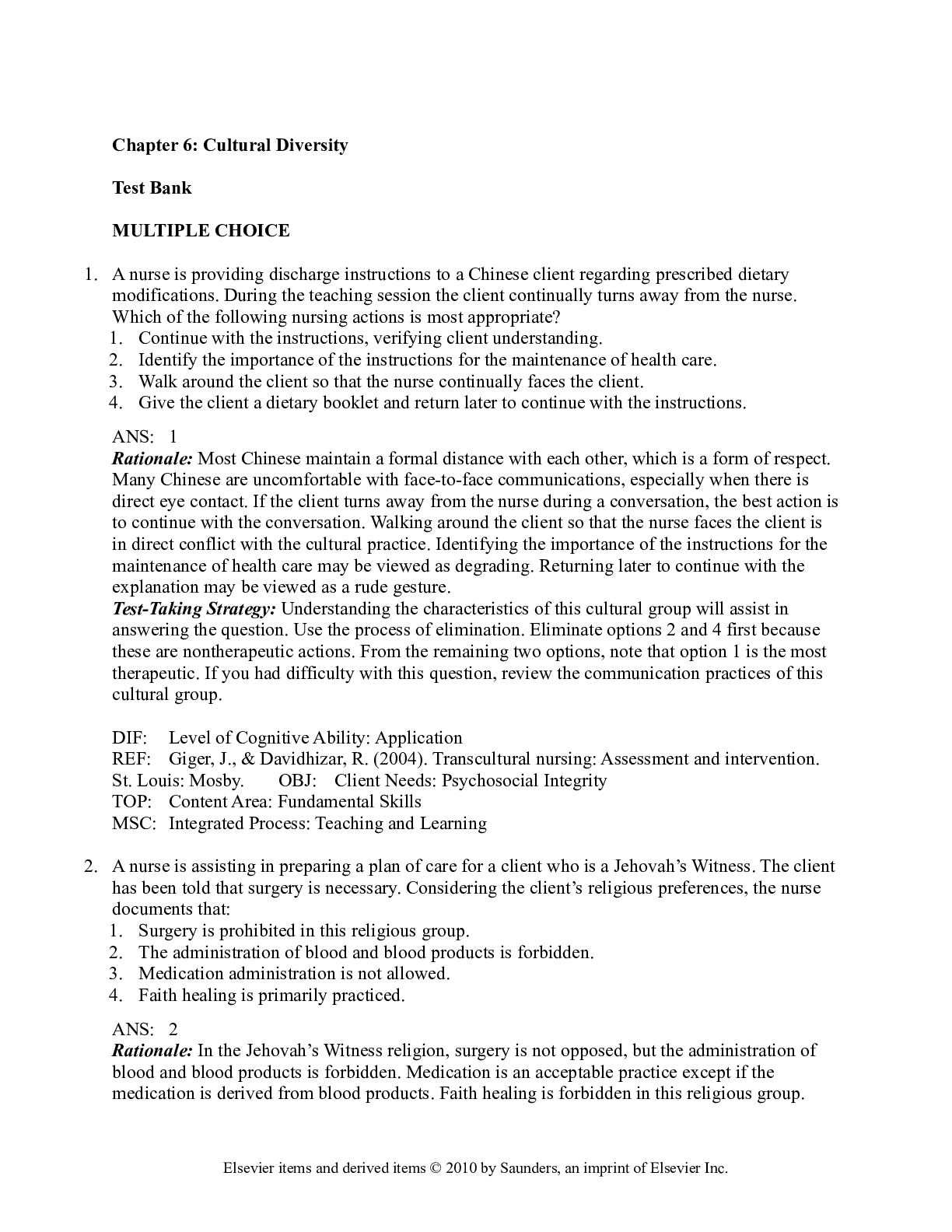

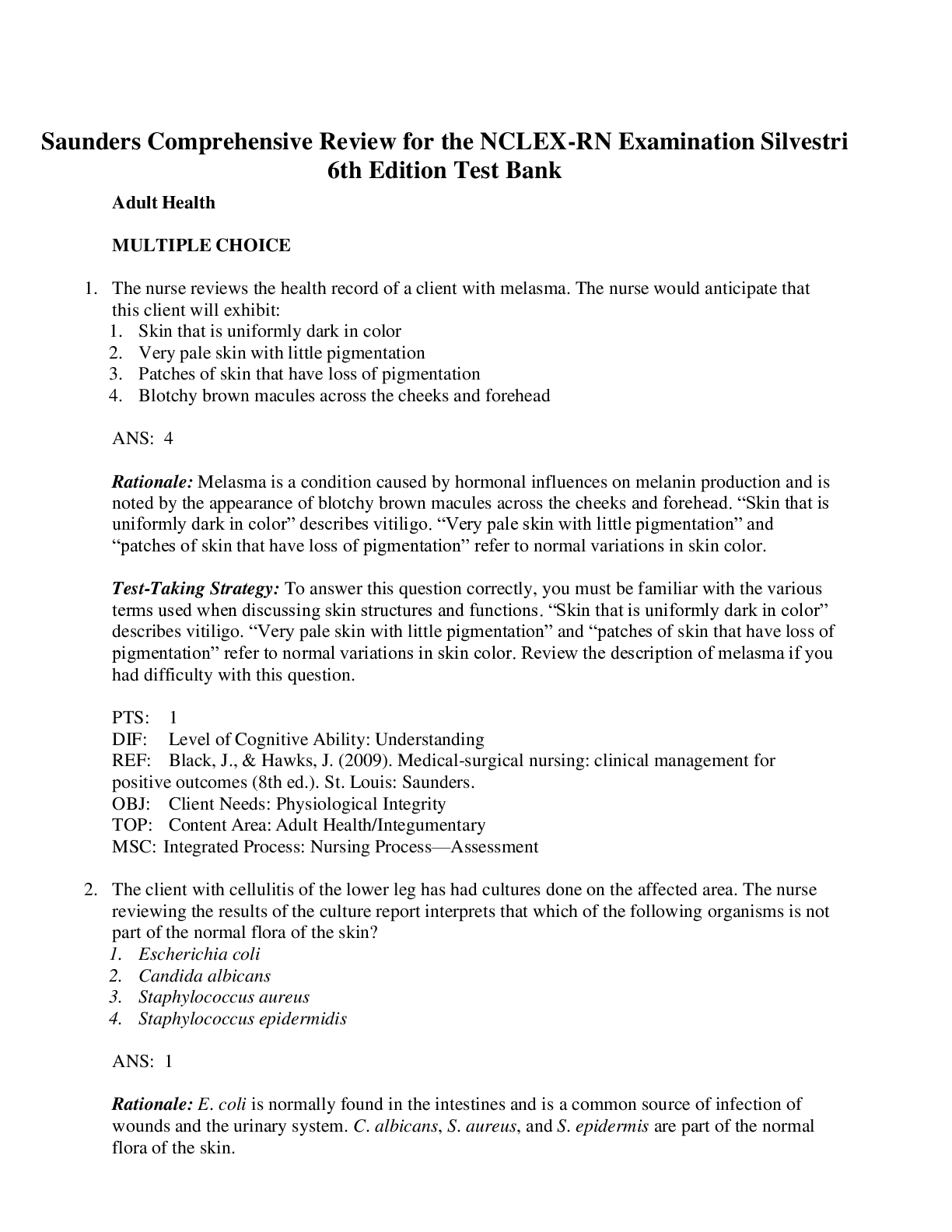
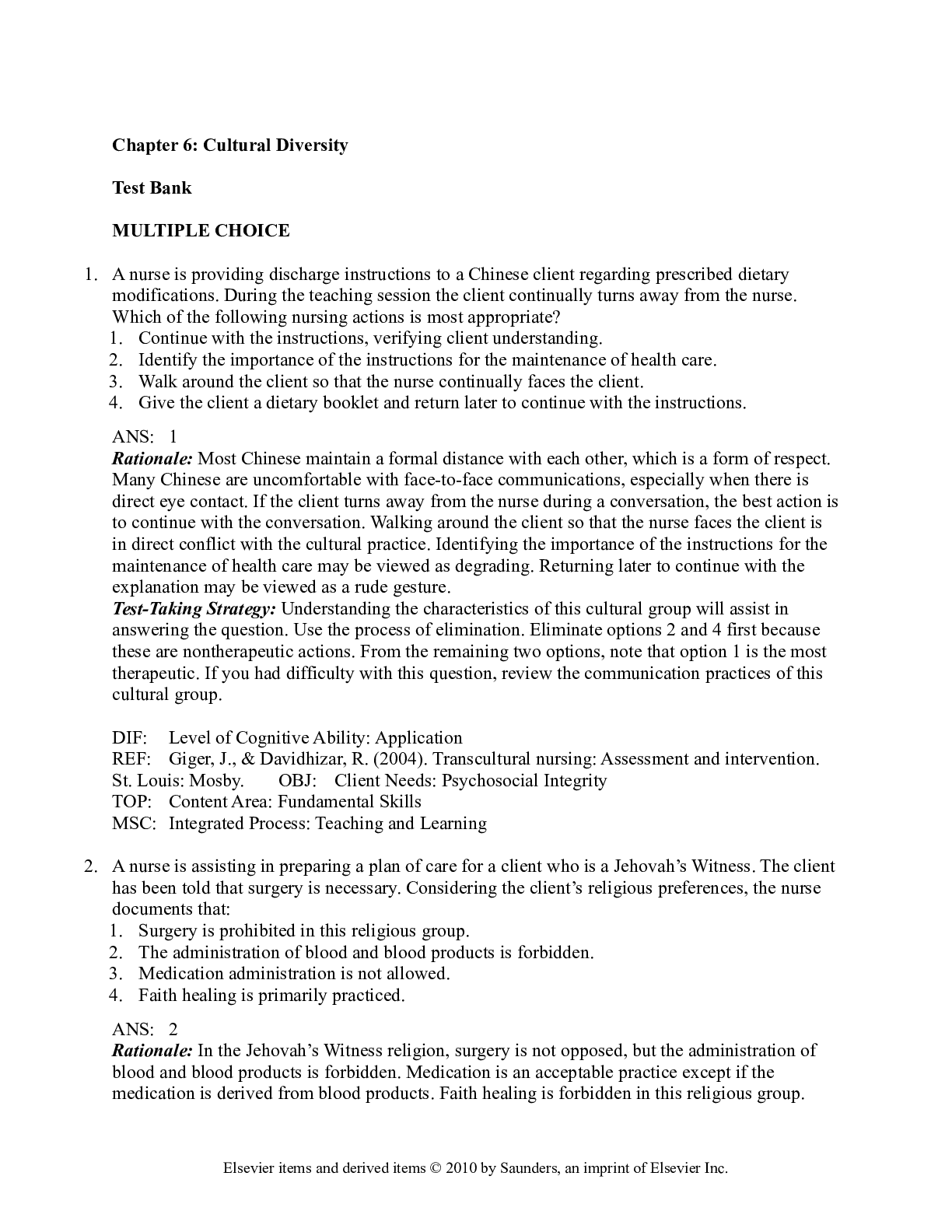


.png)
